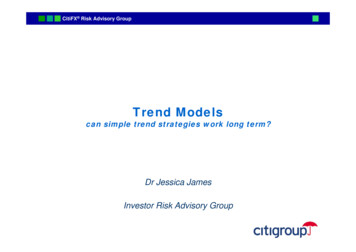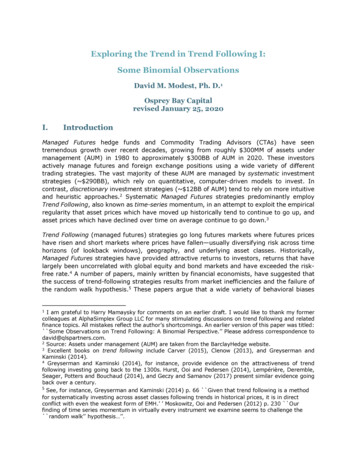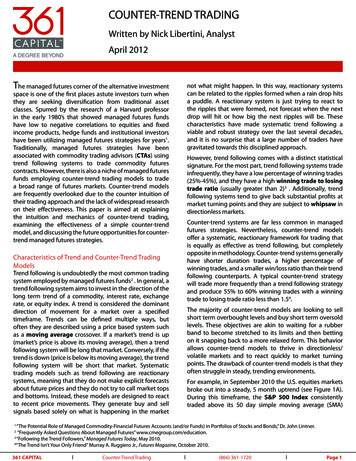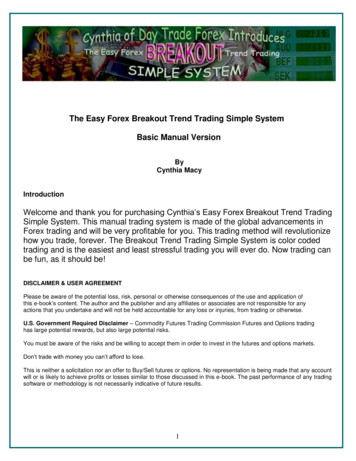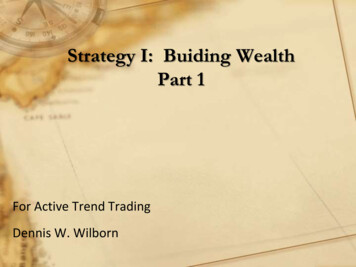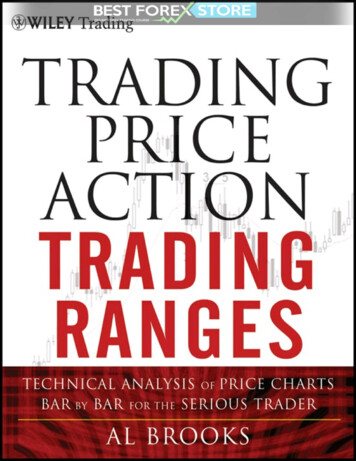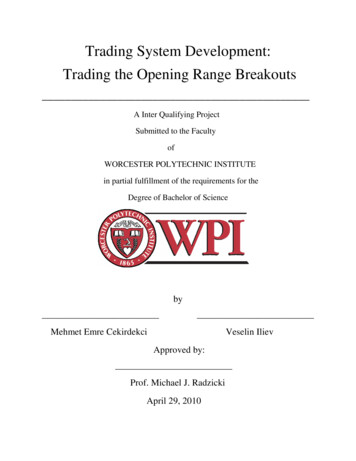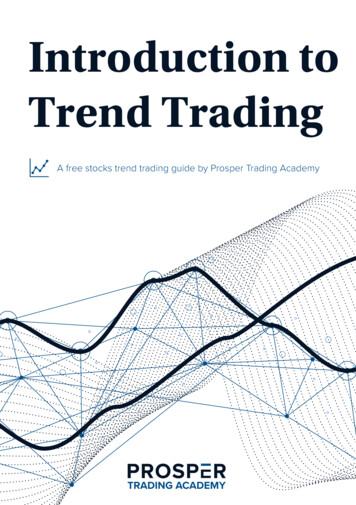
Transcription
Introduction toTrend TradingA free stocks trend trading guide by Prosper Trading Academy
Introduction to Trend TradingA Stocks Trend Trading GuidebyProsper Trading Academy&Dan O’Brien
DAY TRADING involves high risks, andYOU can LOSE a lot of money. Hypotheticalor simulated performance results havecertain inherent limitations. Unlike an actualperformance record, simulated results do notrepresent actual trading. Also, because the tradesactually have not been executed, the resultsmay have under-or over-compensated for theimpact, if any, of certain market factors, suchas lack of liquidity. Simulated trading programsin general also are designed with the benefitof hindsight. No representation is being madethat any account will or is likely to achieveprofits or losses similar to those talked aboutin our site. The information contained hereinis specifically for the limited personal use ofthe individual who purchased this course. Anyreproduction, dissemination or retransmissionof the information contained in this course isstrictly prohibited without the express writtenpermission of Prosper Trading Academy LLC. 2017 Prosper Trading Academy
About the AuthorDan O’BrienSenior Stocks Instructor,Prosper Trading AcademyDan O’Brien has had a long, experienced career as a trader, a brokerand an educator. He has a tremendous track record calling tradingsignals in the E-Mini S&P 500. Dan has developed all the tools with hisover 20 years’ experience in the business - top-notch technical acumen,an in-depth understanding of market fundamentals, a disciplinedapproach to trading and a patientstyle of teaching.
Introduction to Trend TradingMost people with money in the markets today participatevia “buy something.anything.and forget it.” The averageJoe tells himself, “I’m a long-term investor. Buy and holdis for me.” Although that is fine for a portion of his overallinvestment, he fails to realize that there is more to investing,like day trading or swing trading. But for someone who isalready a very long term investor and does not have the timeto sit in front of a computer screen all day, yet can’t stand theidea riding out down moves, perhaps trend trading can reallyincrease his overall returns.From bankers to private trading firms to the average Joe,people actively participate in the markets everyday it isopen. Whether one is a day trader, a swing trader, or longterm investor, speculators provide the necessary liquidityto create an actual market. These traders attempt to profitfrom price changes due to earnings reports, supply anddemand changes, or certain news that they believe will causefluctuations in a stock price.So what is trend trading and how is it different fromday trading and long term investing? Let’s startwith the easy one - long term investing. Almostall long term investors are those that just buyand hold. No matter what happens, they’re notmoving a muscle to help themselves, even when themarket is falling. However, there are some firms,usually hedge funds or RIAs, that short stocks for1
long periods of time, but they are rare indeed. Forexample, investor Jim Chanos gained fame whenhe predicted that Enron would file bankruptcy longbefore it happened and that his firm, Kynikos, wasshort the stock. He held it for the long term; all theway to the bottom price of zero.On the other end of the spectrum are day traders, and theyare looking for brief opportunities every day to either buyor sell in multiple stocks. The day trader will be out of allof his positions before the close of the market the sameday. Day traders have special rules set up by governmentregulators. From FINRA, we read the following:The rules adopt the term “pattern day trader,” which includesany margin customer that day trades (buys then sells or sellsshort then buys the same security on the same day) four or moretimes in five business days, provided the number of day trades aremore than six percent of the customer’s total trading activity forthat same five-day period. Under the rules, a pattern day tradermust maintain minimum equity of 25,000 on any day that thecustomer day trades. The required minimum equity must be in theaccount prior to any day-trading activities. If the account fallsbelow the 25,000 requirement, the pattern day trader will not bepermitted to day trade until the account is restored to the 25,000minimum equity level.The rules permit a pattern day trader to trade up to four timesthe maintenance margin excess in the account as of the close ofbusiness of the previous day. If a pattern day trader exceeds theday-trading buying power limitation, the firm will issue a daytrading margin call to the pattern day trader.2
So if someone does not want to deal with the rules laid outabove, but also wants to be more active than a buy and holdinvestor, swing trading may be right for them. Simply put,swing trading is a medium-term strategy that traders use tocapitalize on the price “swings” of stocks, usually over theperiod of a few days to perhaps a few weeks. This tends towork for individuals and not institutional traders because thelatter are making very large bets on the price of the stockthat may take days to complete, and are meant to be heldfor very long periods of time. This activity, however, is oftenwhat creates the swing trading opportunities for the individualtrader.At Prosper Trading Academy, we believe that the bestcompanies to trend trade should have high daily tradevolume. It would be a good idea to only focus on those stocksthat trade at least a minimum of one million shares per day,while others may decide to use a rule of several multiples ofthat. Trend traders focus on these stocks because their pricesoften move in one direction for weeks in a row. What’s more,since the volume is high, they will have no problem fillingtheir orders. Some stocks that have these characteristics areApple, Amazon, and Facebook to name just a few.Prosper Trading’s students use a systematic approach to themarkets; they are not looking at a company’s balance sheetor next quarter’s sales projections, for example. Our trendtraders are technical traders, which means that they make3
their decisions by what they see and use on the charts: trendlines, moving averages, pattern recognition, volume, etc. Trend traders do not care about fundamentals. Trend traders don’t care much for analyst projections. Trend traders don’t even care what the company sells. They’re just looking forgood movement on a regular basis.Below is a chart of Halliburton, symbol HAL. Here is anexample of a chart based potential trade. The technicalinformation shows a few moving averages that are bullishlysloping up, a trailing stop program that is bullishly supportingthe market, and high daily volume. The green oval is where a4
trend trader may look to initiate a long positions.You will notice that there is no red oval to signify an exitprice. After more than a month of a strong rally, there’s noreason to get out. This is a trend, indeed.During this same trend, day traders and swing traders willalso be buying. Day traders may be biased long multiplestimes per day, however, losers are inevitable. Trend traderswant to avoid the high cost of commissions plus losing daytrades and just sit through a long winner while the profit addsup. Swing traders will buy in this move as well. But doesevery swing trader have the discipline to buy again after heexits with a 5-day winner? If not, then he misses the secondleg of the rally. Trend traders want to avoid both scenarios.Although trend traders are in positions for long periods oftime, they are never “always long,” therefore they have theability to identify weakness in a sector or specific stock andactually profit as it falls. Trend traders take advantage ofthe weakness by shorting the stock in the belief that it can bebought later at a lower price.5
The chart above is also Halliburton. This stock was so weakin early 2017 that a buy and hold investor agonized with theposition for more than 6 months as it plummeted a stunning35%. Trend traders, however, would not be long. Sincethe market is dropping, a trend trader would be short andprofiting during the -35% decline.Another important aspect for any trend trader should berisk management and position sizing. At Prosper TradingAcademy, however, we demand it. Why? If you do not knowexactly what size you should put on and where you will exitif you are wrong, then you are doomed to failure. Like alltechniques, trend trading will not always yield perfect entriesand exits, so you must be prepared for losses.Using Prosper Trading’s scientific position sizing method, youwill know the exact amount of shares that should be used andthe exact stop-loss level that will be used. There will be NOguessing!6
Is trend trading right for you? At Prosper Trading Academywe encourage everyone to find their niche environment.If you can not sit at the computer screen all day for daytrading, or do not possess the skill for swing trading, perhapstrend trading is for you. You may think that swing tradingis the answer and perhaps it is, but that takes discipline too- discipline to exit positions before the adverse price actiontakes the market in the other direction. Can you do that orwould you rather hold out for more cash?Ultimately you must make that decision, but trend tradingmay be a great place to start and all of the pro’s at ProsperTrading Academy will do everything to help you make theright choice.To learn more about the swing trading stocks and othermarkets like penny stocks, cannabis, and cryptocurrenciesemail us ing.com/7
below the 25,000 requirement, the pattern day trader will not be permitted to day trade until the account is restored to the 25,000. minimum equity level. The rules permit a pattern day trader to trade up to four times the maintenance margin excess in the account as of the close of. business of the previous day.
